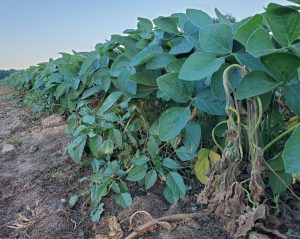
Giant ragweed: Sporadic patches of giant ragweed (Ambrosia trifida) are emerging above the grassline in field edges mostly along ditches and not within field margins. Let your neighbors know if you spot giant ragweed and where as they are not easy to find amongst all the other weeds along ditches.
Palmer amaranth: Pigweeds, mostly palmer amaranth (Amaranthus palmeri) along field crop margins are rapidly growing and are one of the more frequent observations along outside rows adjacent to lawns and sensitive crops in Salem County. For resistance management, these outside rows of half-dead, curled but still living plants are where resistance can develop. If already sprayed, mow these down to the ground or till under even if it means sacraficing the outside row of crop. If sprayed or mowed, monitor the area to make sure pigweeds completely die.
Ivy Leaf morning glory: Ivy leaf morning glory (Ipomoea hederacea) will continue to sprout with this flush of rain. Monitor newly planted double crop soybeans into wheat stubble for flushes moving into fields from field edges.
Marestail: Over all marestails (Conyza canadensis) are under control except in fallowed unplanted and untilled fields with last year’s crop residue still present. Brushog these down before notilling. Marestail is a wind dispersed seed that like thistles, will end up infesting hundreds of acres downwind if allowed to go to seed.
Thistles: Thistles in the Cirsium and Carduus genus are sporadic but on some idled fields extensively spreading by root rhizomes (Canada) and seed dispersal (Bull, Musk). Canada thistle in sandy soils is a life time headache greatly increasing field management costs over time.

